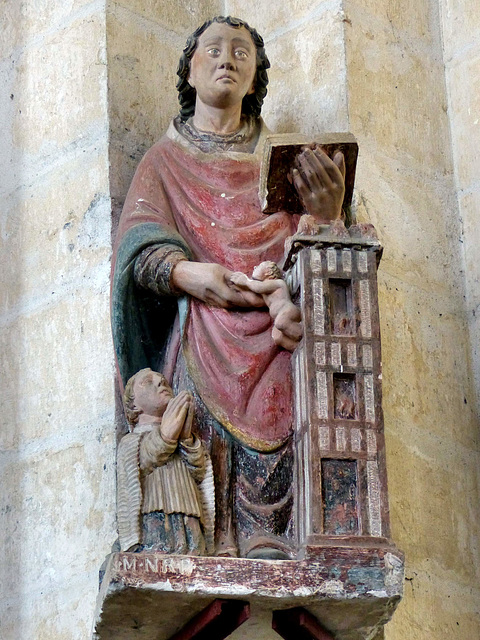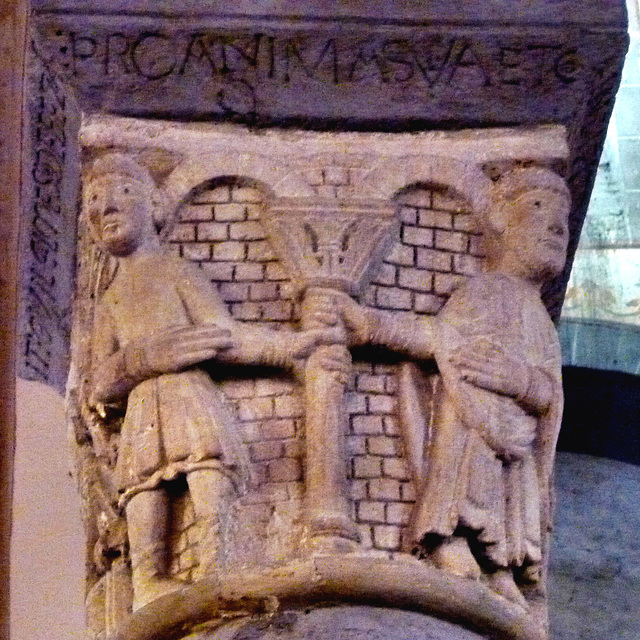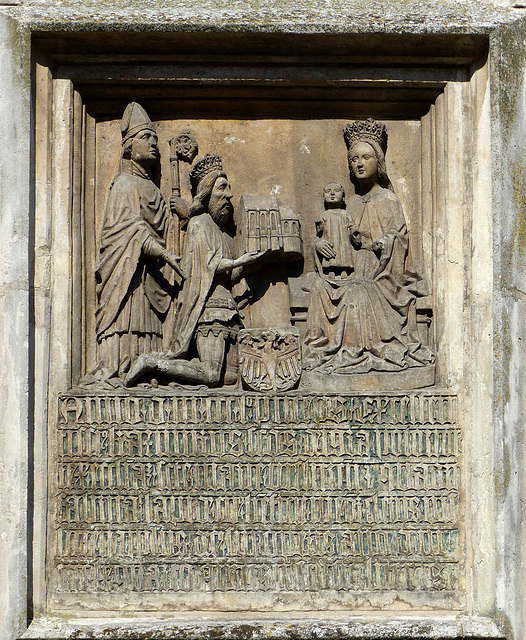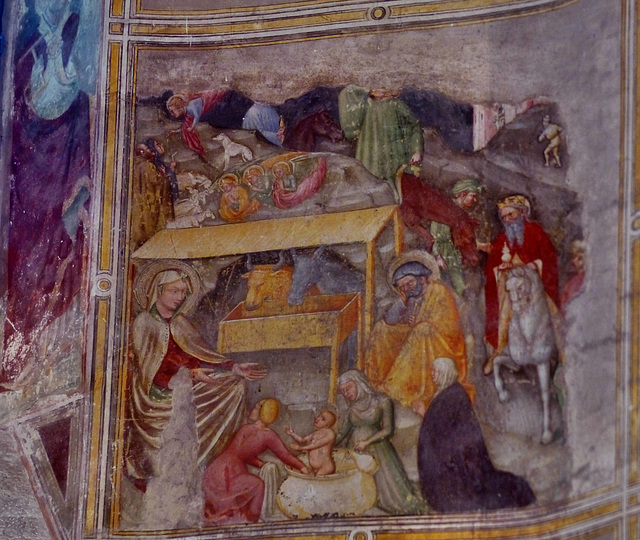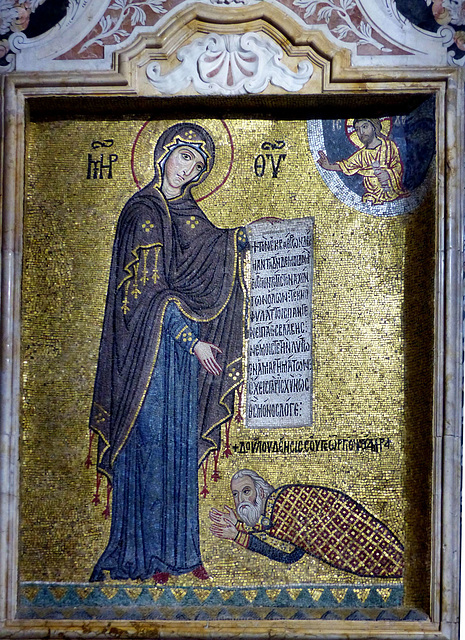
Donors
Donor portraits and donor figures
Chaource - Saint-Jean-Baptiste
The town of Chaource (pop. 1100) is known for the Chaource cheese and the church dedicated to Saint-Jean-Baptiste.
The choir was part of a church built within the 14th century, but from 1531 on the old nave got torn down and was replaced by the nave and aisles seen here.
Chapels were added to the structure – and a great number of sculptures were collected. They survived iconoclasts and revolutionary vandals and now are on display.
Saint Florian (aka "Florian of Lorch"), a martyr under Diocletian's reign and now the patron saint of firefighters? He is often seen extinguishing fires and rescuing people, - but as a Roman soldier, he "normally" wears a kind of uniform and does not hold a bible...
Monte Sant'Angelo - Santa Maria Maggiore
Legends tell, that in 490, 492 and 493 the archangel Michael appeared to a shepherd and a bishop in front of a grotto. Archangel Michael instructing them to convert that cave into a Christian church. This grotto became the site of many pilgrimages since the early Middle Ages. It is said, that this is the oldest shrine in Western Europe
When the Lombards successfully conquered southern Italy end of the 6th century, King Grimoald in 662 passed on the region to his son, Romuald I, who renovated the sanctuary and encouraged its use as a pilgrimage site. It got very popular for pilgrims on their way to Jerusalem and as well for pilgrims who had followed the Via Francigena to Rome and then continued to the grotto. Many Popes have been here, but as well Bridget of Sweden, Bernard of Clairvaux, Thomas Aquinas, Matilda of Tuscany, Otto III...
Only about 100 meters south of the sanctuary is a complex of (once) three interconnected and partially nested buildings. Seen fltr is the portal of the "Tomba di Rotari", the apse of the church of San Pietro and the church of Santa Maria Maggiore.
The current building has a 10th-century predecessor and was built around 1170. The facade had been renewed after the earthquake in 1198. The tympanum depicts Virgin and Child flanked by censer swinging angels. The donors can be seen on their knees.
Volvic - Saint-Priest
There are two products, this small town, near Riom is pretty famous for.
There are the black stones from Volvic, used all over the Auvergne. The gothic cathedral in Clermont-Ferrand is built from the black stones, coming from Volvic.
The younger product is the "Volvic" mineral water. Zillions of plastic bottles, filled with Volvic-water leave this place every week or month.
Long time before Danone (Evian, Badoit, La Salvetat....) entered the stage in Volvic, this place was owned by St. Priest (aka Priest de Clermont, aka Saint Praejectus), bishop of Clermont. St. Priest was stabbed to death here in 676 and immediately was venerated as a martyr. His sucessor Avitor founded an abbey here, that later was depending from Mozac (1169).
The capitals in St. Priest do not have the wonderful, sleek elegance of the carvings seen in the former abbey church in Mozac (5kms east) or Notre-Dame-Du-Port in Clermont-Ferrand (15kms south), but they use the same "icons", that are so typical all over the Auvergne: sirens, griffons, eagles..
According to Bernard Craplet ("Auvergne romane"), who could decipher the inscription running all around the capital, this depicts a donation. On the left is the young lay donor William of Bezac who gives the cleric/prior the column as a symbol for the church, that William had financed. Seen as a "next step" on the back of this capital are two angels consecrating the altar.
Wiślica - Bazylika kolegiacka Narodzenia Najświętszej Marii Panny
The Gothic collegiate church was built in the 14th century under Casimir the Great on the foundations of two Romanesque predecessor churches.
The construction of the first Romanesque church was started by Henryk Sandomierski and completed in the second half of the 12th century by his brother Casimir the Just. It was a small, single-nave building with an apse,
At the beginning of the 13th century the second, enlarged collegiate church was built. It consisted of three naves and had two towers on the western facade. Probably since the middle of the 12th century, the church was the center of a chapter headed by the bishops of Krakow.
The third collegiate church, which is preserved to this day, was founded by Casimir the Great. Its construction was started in 1350, and the lower western mass was preserved from the earlier Romanesque church. The king had it built as an expiatory church for the murder of the canon Marcin Baryczko. The preacher was murdered in 1349, probably with the consent of Casimir. The collegiate church was damaged several times and then rebuilt.
In the late 18th century Wiślica became part of the Austrian Empire. After the Napoleonic Wars it was annexed by the Russian Empire until after WWI.
In 1915, the church was severely damaged by Austrian artillery. The western facade was destroyed along with the 13th century towers. After the war, when Wiślica became part of the Second Polish Republic, the damage was repaired.
Casimir the Great, accompanied by a bishop, donates the Collegiate Basilica to the Madonna, who looks benevolently at Casimir. The carving is from 1464.
Monreale - Duomo di Monreale
Sicily, the largest Mediterranean island, has a long history, that starts around 8000 BC, but later there were Phoenician, Carthaginian, Greek and Roman periods. After the Roman Empire had fallen apart the Vandals tried to take over the island but failed. Finally, the Ostrogoths took possession.
Mid of the 6th century Sicily was conquered by troops of the Byzantine Empire. After the advent of Islam, Sicily got attacked by the Arab forces. Raids seeking loot continued until the mid-8th century.
A Muslim army was sent to the island in 827 but met with much resistance. So it took a century to conquer it and even later revolts constantly occurred
In 1038 the Byzantines invaded the island supported by Norman mercenaries, led by Roger. In 1072, after the siege of Palermo, most of Sicily was under Norman control. Roger´s son Roger II raised the status +of the island to a kingdom in 1130. During this period, the Kingdom of Sicily was prosperous and powerful,
The court of Roger II became melting out of culture from Europe and the Middle East. This attracted scholars, scientists, artists, and artisans. Muslims, Jews, Greeks, Lombards, and Normans cooperated and created some extraordinary buildings.
In 1186 the last descendant of Roger, Constance of Sicily married Emperor Henry VI, the second son of Barbarossa. So the crown of Sicily was passed on to the Hohenstaufen Dynasty. Frederick II, the only son of Constance, was crowned King of Sicily at the age of four in 1198. He became "Stupor Mundi", one of the greatest and most cultured men of the Middle Ages.
-
William II of Sicily built from 1172 here a fort-like complex of buildings, which included a cathedral, an archiepiscopal palace, a royal palace and a Benedictine monastery. In 1183 the monastery became the seat of the archdiocese of Monreale. The town then developed around this complex.
According to a legend, William fell asleep while hunting. The Holy Virgin appeared to him in a dream, suggesting him to build a church here. After removing a tree, a treasure was found, whose coins were used to finance the construction. Well, it is much more likely that Monreale was founded in competition with the bishop of Palermo, who had commissioned the large Cathedral of Palermo.
This would explain the vast dimensions and the splendour of the "Duomo di Monreale" (= "Cattedrale di Santa Maria Nuova"), that with the cloister, is the only building that survived the times.
The interior is breathtaking, but as the cathedral is about 100 m long, there are distances here, not like inside the "Capella Palatina", where all the mosaics are so "near" - plus the visitors can sit down here - and gaze. It is overwhelming. Here are more than 6000m² of byzantine mosaics. The sides of the nave show many very strong parallels to the Cappella Palatina. Here and there probably the same workshop. Probably a large, maybe even a generation-spanning studio of Byzantine artists.
Seen here is King William II of Sicily as the donor. He hands over the church to the Virgin Mary. William´s donation is blessed by God.
Chaource - Saint-Jean-Baptiste
The town of Chaource (pop. 1100) is known for the Chaource cheese and the church dedicated to Saint-Jean-Baptiste.
The choir was part of a church built within the 14th century, but from 1531 on the old nave got teared down and was replaced by nave and aisles seen here.
Chapels were added to the structure – and a great number of sculptures was collected. They survived iconoclasts and revolutionary vandals and now are on display.
Saint Nicholas, Bishop of Myra, one of the most popular Satints ever, known as the "Wonderworker". Depicted here is a miraculous story.
During a terrible famine an evil butcher lured three kids into his house, where he killed them, placing their remains in a barrel planning to sell them off as ham. Saint Nicholas, visiting the region to care for the hungry, resurrected the three boys from the barrel by his prayers.
Bourges - Cathédrale Saint-Étienne
The "Cathédrale Saint-Étienne de Bourges" was erected as a replacement for an 11th-century structure. The construction started probably in the last quarter of the 12th century, around the same time when the builders and bricklayers started in Chartres. The choir of the cathedral was in use by 1214, the nave was finished 1255. The cathedral was consecrated in 1324.
The cathedral covers a surface of 5,900 m². The nave is 15 metres wide and 37 metres high, the inner aisle is 21.3 metres high. There are no transepts, but two aisles on either side forming a double ambulatory around the choir.
The cathedral retains many of its original stained-glass windows, which dates from about 1215, but as well "younger" ones.
The stained glass window of the Magi is dated 1467. On the left, the donors Jean and Martin de Breuil are presented by Saint Jean-Baptiste. The face of the Virgin in the fourth lancet was redone in the 19th century.
Gubbio - San Francesco
A settlement existed here already in Bronze age, pre-Roman times the Umbrian people had a town here, named Ikuvium. After the Roman conquest the town gained importance. The Roman theatre here is the second-largest surviving in the world.
Gubbio became very powerful in the Middle Ages, when Gubbio sent 1000 knights to fight in the First Crusade. Later the city was engaged in wars against the surrounding towns of Umbria.
San Francesco is located in the lower town of Gubbio. The Gothic style church was built by 1256. St. Francis of Assisi, who was closely associated with Gubbio, supposedly was once housed in a room adjacent to the church.
San Francesco may be work of Benedictian monk Fra Bevignate, who engineered the aqueduct supplying water to the Fontana Maggiore in Perugia.
Ottaviano Nelli created the frescoes of the left apse 1410-1415.
A second Nativity scene here. Mary is now seated. Joseph waiting in his typical gestus. The midwives have prepared the "First Bath", watched by donkey and ox. Jesus is standing (!) in the tub. In the background the shepherds listen to the angels and to the right the Magi are approaching. The black lady on her knees is probably the donor of the frescoe.
Palermo - Martorana
Sicily, the largest Mediterranean island, has a long history, that starts around 8000 BC, but later there were Phoenician, Carthaginian, Greek and Roman periods. After the Roman Empire had fallen apart the Vandals tried to take over the island but failed. Finally, the Ostrogoths took possession.
Mid of the 6th century Sicily was conquered by troops of the Byzantine Empire. After the advent of Islam, Sicily got attacked by the Arab forces. Raids seeking loot continued until the mid-8th century.
A Muslim army was sent to the island in 827 but met with much resistance. So it took a century to conquer it and even later revolts constantly occurred
In 1038 the Byzantines invaded the island supported by Norman mercenaries, led by Roger. In 1072, after the siege of Palermo, most of Sicily was under Norman control. Roger´s son Roger II raised the status of the island to a kingdom in 1130. During this period, the Kingdom of Sicily was prosperous and powerful,
The court of Roger II became melting out of culture from Europe and the Middle East. This attracted scholars, scientists, artists, and artisans. Muslims, Jews, Greeks, Lombards, and Normans cooperated and created some extraordinary buildings.
In 1186 the last descendant of Roger, Constance of Sicily married Emperor Henry VI, the second son of Barbarossa. So the crown of Sicily was passed on to the Hohenstaufen Dynasty. Frederick II, the only son of Constance, was crowned King of Sicily at the age of four in 1198. He became "Stupor Mundi", one of the greatest and most cultured men of the Middle Ages.
Palermo, founded in 734 BC by the Phoenicians, became a possession of Carthage and later was part of the Roman Empire. From 831 to 1072 the city was under Arab rule. Following the Norman conquest, Palermo became the capital of a new Kingdom of Sicily and the capital of the Holy Roman Empire under Emperor Frederick II and King Conrad IV.
The Martorana, overlooking the Piazza Bellini, is located next to the "Chiesa de San Cataldo" (right). The church is as well known under the name "Santa Maria dell’Ammiraglio" and serves the Italo-Albanian parish of San Nicolò dei Greci, who officiate the liturgy according to the Byzantine Rite in the ancient Greek language.
The church was founded by (Syrian) George of Antioch, Ammiratus (Admiral) of Rogers II of Sicily, and built in 1143. Originally it was built over the layout of a Greek cross-in-square, but it has undergone numerous structural changes and additions throughout history. In 1435 the church was annexed to the Benedictine convent of Eloisia Martorana.
This mosaic near the portal depicts the donor of the church George of Antioch at the feet of Virgin Mary, dedicating the church to her. I could not translate the "contract" in her hands.
The Virgin and the head of George are original. George's body is the work of a later restoration.
Jump to top
RSS feed- Latest items - Subscribe to the latest items added to this album
- ipernity © 2007-2024
- Help & Contact
|
Club news
|
About ipernity
|
History |
ipernity Club & Prices |
Guide of good conduct
Donate | Group guidelines | Privacy policy | Terms of use | Statutes | In memoria -
Facebook
Twitter

